Child's Play
Damian and Linda's Photography
Exposure
- Exposure is about getting just enough light but not too much
- There are three primary controls
- It's not difficult and rewards practice
- Semi manual modes are a great place to be
I learned to photograph using film in a completely manual camera. It taught me a great deal but I yearned for some automation to help me photograph fast-changing situations. Now our cameras can be so completely automated it's tempting to never leave the comfort of those settings, but sometimes I yearn for control so I can be creative and not chained to the software settings chosen years ago in Japan.
I'm presuming you're reading this because you're interested in venturing out from under the auto umbrella. This post is what I regard as the very foundation of successful photography - exposure. It's a word that gets used to describe the amount of light we allow the camera to capture.
What Is It?
The camera is a light-gathering device. It captures the constant rain of light[1] in a bucket.
The camera counts how many drops of light in the bucket and writes the number to an electronic file. Actually it's a lot of little buckets to give you lots of points of information to define the picture. If we let too much light in then all the buckets are full and the file is completely white:

If we don't let enough light in then there are just some tiny splashes in the bottom of the buckets and the file is more or less completely dark:

A Bit More Detail - Shades of Grey
On a bright sunny day, outside in the sun at the equator, the light is streaming down and bouncing joyously around, higgledy piggledy. There are lots and lots of drops of light. Counting the individual drops is more difficult than it seems, but counting groups of drops is ok. I don't know the correct collective noun for a group of drops of light falling within a given time, so let's call it a banana. If I count light in bananas[2], then there might be 100,000 of them on such a day.
On a very dark day, like the sort of sullen apology for a day one might get in England in Manchester in the middle of January, there may only be 100 bananas. That's a thousand times less light and yet apart from feeling a bit grumpy with everyone, we barely notice. Some might argue that Manchester just does that to people anyway.
If we went out on a moonlit night, there is only one tenth of a banana. That's a thousand times less than our miserable Manchester midwinter morning and a million times less than the bright sunny day with which we started.
A millionfold variation in light levels is a bit much to ask of our cameras. A good camera can capture, in a single image, something like a thousandfold difference between something "very light" and something "very dark". If we set the camera to capture our 100,000 bananas as fully bright, then we took it to Manchester it would only see darkness.
However, you may also have noticed that in morose Manchester you can still see white paper and dark shadows just like you can in the sun, so clearly our mind or eyes (or both) are doing something to make something a thousand times darker - paper in Manchester - still appear white, just like it does in the sun. Even in the moonlight, we notice that's darker than the day but on the whole we have no problem getting about in it. Only when there's no moon do we become functionally challenged to get around in the dark.
All this means we need a way to control the amount of light coming into the camera, but we can't trust our eyes - they are too good at adapting. Many people just don't get that human vision is so amazing.
How Do We Do It In Theory?
Getting control is not very complicated, we control how much light we let into the camera, and how we count the light. To control the amount of light, we have a hole to let light in and a cover over the hole. We can control both the size of the hole and for how long we uncover it. That makes three things in total:
- The size of the hole we let the light in
- How long the hole is open
- How we count the light that comes in
"How we count" used to be set by the film we loaded into the camera, so we couldn't change it until we changed films. For this reason it's often thought of as a less frequent change to make than the other two, but this is no more than a historical habit. Having the wrong film speed set on the camera was a good way to waste an entire film, and so the controls for it were normally a bit more fiddly and a bit more protected from accidental twiddling, or else it was done automagically by a coding on the film case, confusingly[3] known as "DX" coding.
The two other things were the primary exposure controls on the camera and used to get pride of place; the size of the hole with a ring around the lens and the time uncovered with a large, easily found dial on top of the camera. Both were used with the left hand while the right was on shutter-release and film-winding duty.
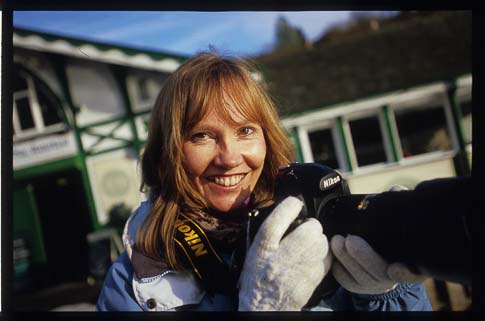
Linda with the D3 showing the left hand right hand thing. Of course these days, it's all on thumbwheels so the left hand has nothing to do but zoom. But it's a nice picture of Linda, and that's the main thing.
All three were and are defined so that a step of one is equivalent to a step of any other; this means we could to a large extent dance between them by counting clicks and not take any notice of the actual numbers.
It's still the same today, although depending on the camera the controls may be more or less accessible. We just step around to find a combination of counting, hole size and time open to match the current light conditions. Not that hard, hey?
The Hole Size Control - Aperture
"Size of the hole" doesn't sound grand enough, so we are inclined to call it "aperture".
There is a pattern of numbers which used to be engraved on lenses and is now displayed in an LCD panel[4]. The pattern goes something like:
1.4 | 2 | 2.8 | 4 | 5.6 | 8 | 11 | 16 | 22
Each of the intervals is equal in terms of the change it makes, and the interval is known as "1 stop" or "1 f-stop" with that funny long f. It's not time to get mired in details about why it's called that or where it comes from - you don't really need to know that unless you are going to design lenses.
The really irritating thing for me about f-stops is that a little number means a big hole and a big number means a little hole. I know there are good technical reasons, but it's not intuitive.
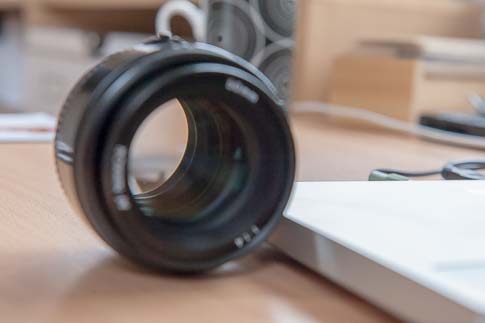
A big hole, also known as "f-stop 1.4" or just "f1.4"
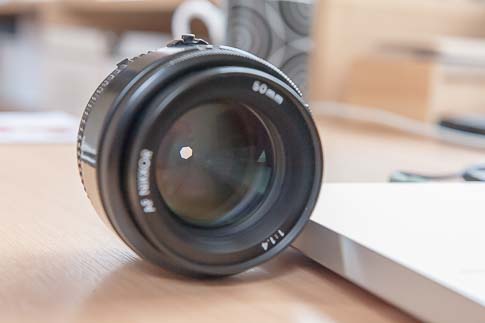
A little hole, also known as "f22"
The numbers for f-stops go in a non-obvious progression, with twice the area of hole being signalled by (drum roll) a factor of √2. You might not remember that symbol if you live in the real world, it means the "square root" of 2. Don't worry, because you don't really need to know about it. If you're an apologist you might point out that a doubling of the area means an increase of √2 in diameter. I don't care, there's no excuse for having such an inaccessible set of numbers that I'm supposed to use when I'm cold, wet and tired.
Anyway, enough of my grumbling, because you soon get used to "counting clicks" on your camera as you set these numbers, so it doesn't actually matter if the sequence makes no sense to you.
The Time Uncovered - Shutter Speed
The second control is how long we uncover the hole for. This is referred to as "shutter speed". The shutter is nothing more or less than a thing that shuts the hole - but for an accident of history it could be called the "opener", which would arguably make more sense. Camera designers want to work with steps that halve or double the amount of light in order to get control of exposure, so that the step size matches the step size in aperture.
Yet again, working with "ordinary" numbers is too easy[5]; the numbers on your camera are the bottom line of a fraction, giving you the time in seconds your shutter isn't shut. So when your camera says 250 it actually means the shutter is open for 1/250th of a second.
If you want more light, you need it open for longer. Is that 125 on the dial or 500? It's 125, because that means 1/125th of a second, which is 2/250ths of a second - twice as long. Not really intuitive, but I mustn't keep grumbling.
This notation gets a bit inconvenient if you hold the shutter open for a very long time, if you're using a tripod for example, so the camera will add double quotes after the number if it is in whole seconds - thus 2 means 1/2 a second and 2" means 2 seconds.
Once again, this all sounds more difficult than it actually is. You soon get used to counting clicks, and a smaller number means more light, so it is at least consistent with aperture control.
That Third Thing
Earlier I described the camera as counting drops of light, in groups I called bananas. Go with me on this. On one of our really bright days, we count our drops in bananas and count them 100 bananas at a time. If there are less than a thousand bananas from something then it looks black in the picture and if we get 100,000 bananas or more it looks white. In Miserable Manchester meanwhile, we count our bananas 0.1 at a time. 100 drops looks white and 0.1 - one tenth - of a banana or less looks black. I don't know exactly how many drops are in a banana, but it's plenty, so we don't need to worry that 0.1 bananas might not be not a whole number of drops.
The "rate at which we count" is the ISO setting. ISO stands for "International Standards Organisation" and so ISO is a shorthand for ISO 12232, a standard procedure for defining this counting rate in digital photography. As you can see, there are at least 12231 other standards which cover everything from the colour-fastness of toilet paper to requirement for a condom to stretch 600%. I'm not making up either of those. When I was a boy, what is now called ISO was referred to as "ASA", the American Standards Association, but in this new-fangled global society we've gone all international.
In common with shutter speed and aperture, ISO numbers are defined so that one step is one "stop" - a halving or doubling of light. In a completely inexcusable mess of a way, though, ISO numbers go up when you want to make the picture lighter. Just to be clear, ISO doesn't actually change the amount of light coming in through the hole, it changes the way you count it. A "one stop" change in ISO is a doubling of the number. From 100 to 200, 200 to 400, 400 to 800, etc.
Again, you get used to counting clicks as you dance around, so the theory sounds much worse than the practice turns out to be.
Typically counting drops very finely makes for worse pictures than counting them coarsely, for reasons I won't go into right now. In general, keep the ISO setting as low as practical for good image quality.
The Story So Far
In summary we've got aperture and shutter speed and they are both defined in such a way that the familiar definitions give us something where a bigger number means less light. We've also got ISO, defined such that a bigger number means a brighter picture.
One thing that is very convenient is that one stop of aperture changes things the same amount as one step (halving or doubling) in shutter speed, which in turn as the same as one step in ISO, so we can to some extent dance between them.
These halving and doubling steps get referred to as "stops" because of the mechanical way cameras were and are implemented - you pushed something until it stopped against something. With menus and buttons the connection is less obvious, but the terminology remains.
How Do We Do It In Practice?
To take complete control of the camera, set in Manual mode. This is probably marked as M and details of how to do it for your camera are in the instruction book that came with it - it's difficult for me to describe it for every possible camera. You're looking for something marked "mode", or possibly "PSAM", or on Canon cameras PTVAVM.
Next, make a guess. For a sunny day, try ISO 200, f8, 1/125th second. Make these settings on the camera. Many cameras show you at the bottom of the viewfinder or else on a menu screen at the back what you currently have as settings.
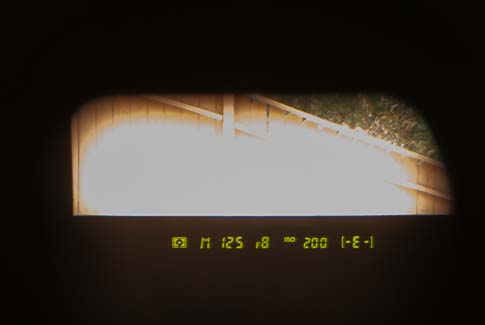
The camera displayes the settings in the viewfinder so you don't have to keep taking it down from your eye to check.
The first time you do it, it will all feel very cumbersome. This is completely normal.
When you look through the camera and half press the release button, you will see some sort of meter display in the viewfinder. It normally consists of a group of vertical or horizontal ticks, with 0 in the middle and going from +3 to -3, or sometimes +2 to -2. They aren't always labelled with numbers, like the ones in my D3 below. The large intervals are one "stop" - the halving and doubling steps described above.
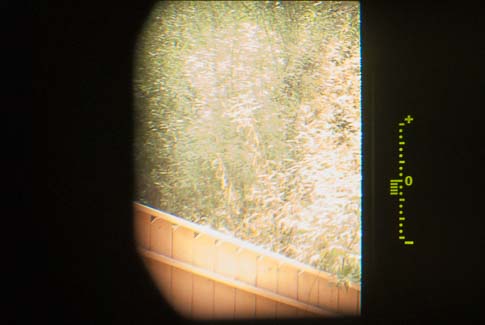
My D3 here is showing I am underexposed by about 2/3 of a stop.
All you do is twiddle with aperture and/or shutter speed until the meter reads 0, and then you have about the right amount of light for the scene. If the meter reads low, keep reducing the aperture and/or shutter speed until it arrives at the middle (bear in mind if you are way off, the meter will be just stuck at one end or the other until you get somewhere close).
Trust the theory and it will get you there - bigger numbers, less light, smaller numbers, more light.
Between 0 and 1, and between 1 and 2, etc, there are typically some subdivisions - usually two extra ticks to give three spaces. These represent one third of a stop. Many modern cameras are capable of working in one-third stops, so in fact there are two finer choices available between, say, 1/250th and 1/125th, but that's a bit of a detail and doesn't really change the fundamentals.
That Sounds Easy, What Could Possibly Go Wrong?
Well, yes. There are a couple of wrinkles you may encounter.
The first and most obvious one is that some of the choices the camera will let you make might well be bad for your pictures. It isn't your mother and it won't stop you from doing things that might turn out unhelpful. In the days of film, if you didn't know this, you wasted a lot of film. Ask me how I know.
The Big One
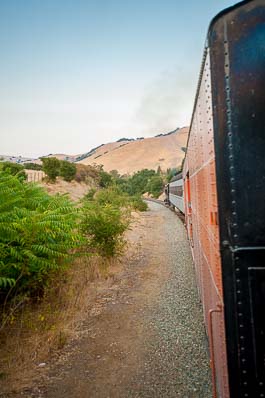
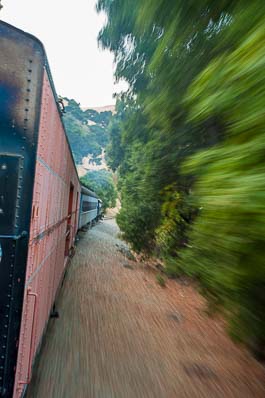
The big one is that the hole is open for so long that you can't hold the camera still to get a sharp picture. Typically, the hole is open for a really short period of time and so it's no problem, but if you make the hole very small and there isn't much light, you will find the hole needs to stay open for longer and longer. If you don't know the focal length[6] of your lens, then try and keep the shutter speed above 60 (or below 1/60th of a second if you prefer to think of it that way). If you do know the focal length of your lens, try and keep the shutter speed number above the focal length. So if you have a 200 mm lens, try not to go lower than about 250 on the display or 1/250th of a second[7].
If you are indoors then you might find you are at the lowest aperture (sometimes referred to as the "widest" aperture) and your shutter speed is nowhere near high enough. When I was a boy that meant you either got out a flash gun, loaded some "fast" film or just put the camera down. These days, professional cameras like the Nikon D5 can take perfectly acceptable pictures in light in which it is impossible to read unaided and so there is no need to resort to mood-ruining flash.
Of course, all rules are made to be broken - compare the technically good picture on the left above with the rather flawed one, below it. Which one makes you feel like you are on the train ride? This is why I like having control.
As the light goes down, you keep turning up the ISO until you run out. It's good to leave this step until last because high ISO tends to add "noise" to pictures - a sort of grittiness that can be unappealing in large doses.
At the other end of the scale, there is only so fast the shutter can go - typically 1/2000th or 1/4000th of a second. At wide apertures on a bright day with a high ISO, there can be too much light. Closing the aperture or lowering the ISO fixes this.
The Other One
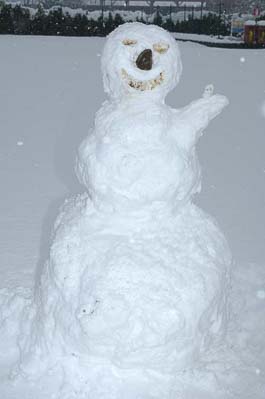
The other wrinkle is that what the camera thinks is right might not actually be right. When the camera measures the amount of light, it gets referred to as "metering" - using a light meter to make a measurement.
There have been tremendous advances in camera metering since I was a boy. Nevertheless the camera is looking at what you want to photograph and measuring the light being reflected off it. This is OK if the thing you are photographing gives off an "average" amount of light - like grass or a person. However, some things - swans, brides, snowmen - give off more than average light. The camera will darken the picture to try to make it more average. Similarly, for something dark the camera will try to lighten it to make the picture more average.
You can see this effect in the background of the snowman picture, which was taken in full dayight on a snowy day. My challenge was to lift the snowman away from the background, so I turned on the flash to expose the foreground more brightly than the background. It took me nearly as long to get the picture right as it did to build the snowman.
To get a true measure of the light falling on a scene, we need a different sort of light meter, known as an "incident" light meter, but your camera hasn't got one. It's not incident in the sense of "The Yangtse Incident" but incident as in "incoming". If you had an incident light meter (I have one by Sekonic), you wouldn't be reading this, I expect.
Your camera probably has several metering "modes" you can use to help get round this problem. For a long time, the default metering mode was known as "centre-weighted average". It looked at the whole picture but paid more attention to the middle, since many people place the thing they are interested in broadly in the middle.
In the late 1980s/early 90s, a metering method known as "matrix" metering was introduced. This basically looks at a number of different points and tries to guess what the scene is. For example, if the top half of the picture is very bright and the bottom less bright, we might be photographing a landscape. Depending on where the split between the two is, we can take a guess if the photographer is more interested in the sky or the land, and skew the exposure accordingly. It's not perfect but to be honest it's pretty useful. Now we have more sites in the matrix, colour 3d matrix metering and all sorts; in the end, even on manual mode pick the best metering setting you can. Lots of practice with your camera will help you understand how and when the metering gets fooled.
Finally, some but not all cameras have what is known as "spot" metering - you pick something that you know is about average and meter just on that. It's a good get out of jail card - rummage it up in your manual and give it a go.
And consider this, too: the metering is fooled whether or not you are in manual mode. It's just that in manual mode you can change the settings, have another go, and move on. In Auto mode you need to go and look up where the exposure compensation button is and use that. Ironically, if you know how to use that, you probably don't need auto mode.
The Real World
By the time you've got this far, you are thinking that although you can do the manual thing, it's not for you. Every picture is different, it's all a but slow, and so on.
And you'd be right.
Having mastered fully manual mode, it's time to step back up to one of the semi-automated modes. I use aperture priority (A on my camera, AV on a Canon) almost all the time. And when I say almost, I mean out of 50,000 pictures I might switch to manual for 10 or 20 of them. There has to be a specific reason - wanting to force the exposure to make pictures stitch together, or working with studio lights (which I don't do much these days) to make me go back to manual.
Aperture priority lets me set the depth of field - how much of the picture is in focus - by a choice of camera angle and aperture. A wide aperture with a low depth of field is great for being certain what's the emphasis of the photo, and can blue out background clutter very easily.
Shutter priority, S on my camera, TV on a Canon, let's me choose the shutter speed and the camera changes aperture to get the right exposure.
Both shutter and aperture priority let me work fast. In fact, I'm so accustomed to running in aperture priority that I just force the shutter speed to what I want using the aperture, and don't usually bother with the shutter priority mode.
Many cameras now offer an "auto ISO" feature", which allows you to vary aperture and shutter speed manually while it chases the correct exposure by dancing around for itself. This means full creative control with no distractions about exposure, and feels like heaven to me.
And full auto? I seriously don't know if I have ever used it on my D3.
Conclusions
- Exposure is about getting just enough light but not too much
- There are three primary controls
- It's not difficult and rewards practice
- "Semi manual" modes are a great middle ground
Damian Harty
Damian is a trained engineer with Bachelor and Master's degrees and a Fellow of the Institution of Mechanical Engineers. This goes some way to explain his inability to simply use technology but his preference rather to deconstruct it and write down what he finds. And then use it.
[1] While I use a "rain of light" as a metaphor, it's not a bad one. Light comes in little drops called "photons" and the camera really does count photons. Quite quickly, obviously, since it can count to about 4000 in ten million places, three times over in a single second in the case of a D40 and to about 16000 in twelve million places, ten times a second in the case of D3s. That's a lot of counting.
[2] Light levels are actually measured in "lux". A lux is 1 lumen per square metre. You might not want to know what a lumen is, but if you do then it's the total luminous flux emitted into a solid angle of one steradian if a light source emits one candela of luminous intensity uniformly across that angle. I did say you might not want to know and it's not my fault you kept reading.
[3] Actually, it's not confusing. Or at least it wasn't until a certain camera maker decided to recycle the DX acronym and use it for sensor size. Boody millenials.
[4] In a lot of cameras there are some intermediate positions between the numbers above, known as "half stops" if there is one and "third stops" if there are two.
[5] I'm being unfair in deriding the early pioneers who worked all this stuff out. How were they to know that the world's population would grow towards 7 billion and that we'd have cameras on our mobile telephones? By the time it's become popular the terminology is too embedded to change, so unfortunately you just have to deal with it. But I am sympathetic about how confusing it looks to an outsider.
[6] Don't worry what this means, we'll get to it in another post. Probably.
[7]This is an old school "rule of thumb" and not any sort of hard and fast boundary, just a helpful thing to keep in mind. If your hobby is being an Olympic marksman, you might have quite a steady hand and will laugh at the 1/focal length rule. If you have some sort of nervous affliction you might find it isn't enough. It's just a guide, ok?
© 2006-2016 Damian Harty. Design by Andreas Viklund.